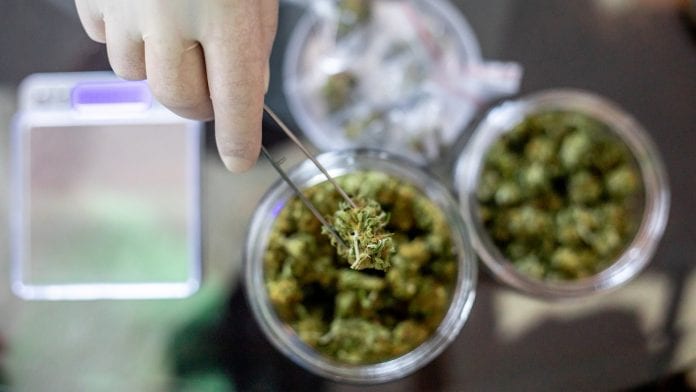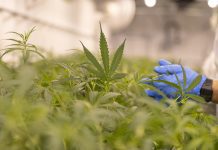
Researchers at Meir Hospital are investigating the therapeutic potential of cannabis for a number of indications.
In the last few decades, the world has witnessed a dramatic change in the attitude towards cannabis, from being classified as a Schedule 1 illicit drug to being used for numerous medical purposes. Although the popular public opinion is that cannabis is a remedy to almost any ailment under the sun, the reality is that very little sound scientific evidence to justify this notion exists. Moreover, the popular opinion regards cannabis as a very safe, harmless substance, but lessons learned from cannabis legalisation prove that cannabis consumption is associated with side effects that may be significant.
The introduction of a new drug in the medical world is a long and tedious process. Full awareness of the huge responsibility involved in introducing a new treatment for any disease has resulted in a demand for a meticulous, long and expensive process of carefully controlled medical trials, conducted under strict supervision, before the use of any new medication is authorised. Strangely, cannabis seems to have escaped this process. The decisions about cannabis use, just like any other medicine, should be bound to scientifically sound evidence concerning the efficacy, treatment indications, dosage, mode of consumption and close monitoring of risks and side effects. Instead, the decision as to whether cannabis should be used in medical treatments has been left in the hands of politicians and public opinion leaders.
The lack of scientific evidence has led us at Meir hospital to the decision to conduct appropriate medical studies to try to determine whether cannabis can be used medically, and if so, how it should be used. We want to implement the traditional conservative approach of drug development in the new and innovative field of medical cannabis.
Trials of cannabis use in patients with inflammatory bowel diseases
The first efforts were directed toward inflammatory bowel diseases. Those are two separate diseases: Crohn’s disease, in which inflammation can affect any part of the gastrointestinal tract, and ulcerative colitis, in which inflammation is limited to the large intestine only. In both instances, the inflammation results in symptoms such as abdominal pain, diarrhoea and weight loss. Only 60% of patients respond to currently available treatments. Many patients with inflammatory bowel diseases report that cannabis ameliorates their symptoms, but since no appropriate studies were conducted, it was impossible to draw any conclusions. The first study we conducted was a retrospective observational study, in which we collected data about disease activity before and after cannabis consumption. It turned out that disease activity improved in this cohort of patients; however, as cannabis use was variable and there was no control group, further studies were obviously needed.
We than conducted several double blind placebo-controlled studies of cannabis in inflammatory bowel diseases. The first one included patients with active Crohn’s disease, who were randomly assigned to use either cannabis in the form of cigarettes, or placebo. In order to maximise the similarity between the placebo and the cannabis, so that patients will not be able to guess what they are receiving, the placebo cigarettes were made of cannabis flowers from which all active cannabinoids were extracted. This study was innovative in several respects: it was the first double blind placebo-controlled study of cannabis in Crohn’s disease; all patients received identical cannabis with a known composition; and the study was prospective. At the end of the eight weeks of the study, patients receiving cannabis had a significantly lower disease activity index, but no change was observed in inflammatory markers. That study, however, had several limitations: the study group was small; it lasted only eight weeks; and endoscopic disease activity was not assessed.
Needless to say, smoking is associated with the production of noxious pyrolytic byproducts formed by combustion, resulting eventually in pulmonary damage and the development of lung disease. We therefore chose an oral route for the administration of cannabis, which was delivered in the form of oil extract. Again, at the end of the study we observed clinical and symptomatic improvement, but objective inflammatory markers and endoscopic findings did not change.
Last but not least, we performed a study of cannabidiol alone for the treatment of active Crohn’s disease. Patients received an oral dose of 20mg cannabidiol per day. No difference in disease activity between the study and control group was observed at the end of the study. These negative results could be due to the small dose that was used, the oral method of ingestion, or maybe CBD truly does not have an effect in Crohn’s disease.
The good safety profile of CBD, combined with experimental data showing the good anti-inflammatory effect of CBD in various experimental models, prompted us to try CBD in steroid-dependent Crohn’s disease patients. The study, which is double blind and placebo-controlled, is still ongoing, therefore no conclusion can be drawn yet; but we hope that CBD will emerge as an additional therapy that can reduce steroid exposure.
Trials of cannabis use in chronic spontaneous urticaria
Chronic spontaneous urticaria (CSU) is a mast cell-driven disease that is defined as the occurrence of weals, angioedema, or both for more than six weeks. CSU affects up to 1% of the general population, exerting a devastating impact on patients’ quality of life. The pathophysiology underlining flares of CSU is not entirely clear. However, Histamines and other mediators such as platelet-activating factor (PAF) and cytokines released from activated skin mast cells are suspected to have a pivotal role, eventually causing allergic inflammation which presents as weals and oedema of the upper and mid dermis.
Cannabidiol (CBD), a non-psychotropic ingredient of Cannabis sativa, possesses potent immunomodulatory and anti-inflammatory properties as described in both acute and chronic animal models of inflammation. Based on the positive safety and initial efficacy profiles of CBD in other immune-related diseases – namely inflammatory bowel disease and graft versus host disease – we hypothesised that sustained doses of CBD could exert similar or stronger effects as compared to standard steroid therapy and possibly facilitate steroid tapering or cessation in CSU patients.
We aimed to evaluate CBD as a steroid-sparing therapy in patients with CSU refractory to high doses of antihistamines that need treatment with recurrent courses of systemic corticosteroids. In the current proof-of-concept study, patients with refractory CSU treated with recurrent courses of systemic corticosteroids were administered increasing doses of CBD. The initial dose was 25mg BID, which was gradually increased to 150mg BID if no side effects were observed. At the conclusion of the six weeks of CBD dose escalation, patients would continue receiving 300mg CBD+ antihistamines PRN for an additional period of three months.
The effect of treatment will be evaluated by the treating physicians using the Urticaria Activity Score (UAS7), SF36, visual analogue scale (VAS), cognitive quality of life (QoL) questionnaire and Hospital Depression and Anxiety Score (HDAS) every two weeks. The study is ongoing and the data has not been summarised yet. However, the investigators’ impression is that in a substantial cohort of the patients, CBD is having a significant beneficial effect. This is supported by the positive feedback from the patients. We hope that at the end of the study the clinical positive effect will be supported by the objective data.
The future of cannabis research
Cannabis studies are particularly challenging from several aspects. The central effect makes the creation of a placebo more difficult and increases the probability of side effects. The huge variety of cannabis plants poses the tough question of which of all its chemovars would be most effective in the treatment of which disease. The status of cannabis as an illicit drug imposes further difficulty. Plant extracts are not uniform and can never reach the reproducibility required from a medicine. All these obstacles have induced us at Meir hospital to establish a cannabinoid research centre which will benefit from the co-operation of various disciplines. A group of medical experts from various specialities will discuss and develop future studies. The centre will combine a research laboratory that will investigate various cannabis chemovars in various experimental settings in order to identify those that seem most promising. Additionally, specific cannabinoids without central effect, such as cannabidiol, will also be studied. These will then be taken on to clinical studies and hopefully to the development of future treatments.
In conclusion, cannabis is a substance that seems to be a promising candidate for the development of future therapy. The complicated composition of cannabis plants and their psychotropic effect make cannabis research more challenging, but its potential must not be ignored. In this article we have presented several examples of the clinical research conducted in our hospital so far, but we are convinced that the collaboration of several medical disciplines, with the support of the hospital laboratories and availability of patients eager to participate in cannabis studies, will guarantee more high-quality research.
This article is from issue 18 of Health Europa. Click here to get your free subscription today.




















